Abstract
The synthesis of adjacent overlapped Stokes spectra in two stages of a transient stimulated Raman chirped-pulse amplifier, tuned respectively to the vibrational modes at 901 and 767 cm−1 of a potassium gadolinium tungstate [KGd(WO4)2] crystal, is demonstrated. The contribution of the spatio-temporal overlap of seed and pump pulses, as well as the self-phase modulation, was investigated. The noncollinear configuration allows the composite bandwidth at the central wavelength of 1120 nm to be increased by a factor of 23 compared to the pump pulse bandwidth of 1.6 nm. After reaching a conversion efficiency of 35% in the second stage, the compressibility of a chirped Stokes pulse with a tailored spectrum was also investigated.
1. Introduction
The inherent phase matching gives stimulated Raman scattering (SRS) an important advantage in wavelength conversion and pulse compression. However, SRS is highly transient for pulses shorter than a few picoseconds, since the vibrational dephasing times in most of the known gaseous, liquid, or crystalline media are much longer. This leads to a significant increase in the SRS threshold [1], a drop in conversion efficiency and competition from self-focusing, self-phase modulation (SPM), and a supercontinuum (SC) [2,3]. Several attempts have been reported to overcome these obstacles. SRS of chirped pump pulses [4] eliminates undesirable nonlinear effects, but the concomitant spectral narrowing leads to a 2–3-fold increase in the pulse width of compressed Stokes [4,5], although this narrowing has been resolved [6]. SRS conversion in gases [7] and solids [8] has been demonstrated with an efficiency in excess of 20% with Stokes recompression to less than 100 fs. Transient stimulated Raman amplification (SRA) of femtosecond pulses increases conversion efficiency and provides additional spectrum broadening [9]. Accordingly, the SRA conversion efficiency of 50% [10] or 5-fold spectral broadening compared to the pump with SC pulses [11] in potassium gadolinium tungstate [KGd(WO4)2] (KGW) [12] crystals have been reported.
However, broadband excitation pulses were still implied to achieve a pulse width below 100 fs, and no gain in peak power at the Stokes wavelength occurred until recent experiments on transient stimulated Raman chirped-pulse amplification (TSRCPA) in KGW pumped by 1.2 ps transform-limited pulses [13]. At a Stokes shift of 901 cm−1, a conversion efficiency of 55%, an amplified Stokes bandwidth ~10 times wider than pumping, and ~8-fold compression were achieved. Moreover, in a single KGW crystal, an overlap of different vibrational Raman lines resulted in a maximum spectral bandwidth sufficient for transform-limited pulses of 80 fs. Indeed, the orthogonal polarization of the short-wave and long-wave parts of the composite spectrum did not allow compression. Thus, it is important to investigate the limits of maintaining the TSRCPA spectrum bandwidth with high conversion efficiency and compressibility of amplified Stokes pulses.
Continuing to develop the above concept, we investigate here for the first time the synthesis of a composite spectrum obtained from two successive TSRCPA stages tuned to vibrational modes at 767 and 901 cm−1 of the KGW crystal, respectively. For this purpose, we reveal the contribution of the spatio-temporal overlap of SC seed and pump pulses, the SPM of the pump, and the Stokes and spectral overlap of adjacent vibrational Raman lines. Experimentally, a record 23-fold increase in the composite spectral bandwidth of amplified Stokes pulses was achieved in comparison with pump pulses.
2. Experimental Setup
The anisotropic KGW crystal exhibits several intense spontaneous Raman vibrations that can be excited along different crystal axes. The most intense adjacent Stokes lines at 767 cm−1 (Ng-axis) and 901 cm−1 (Nm-axis) can be excited in successive TSRCPA stages. A short dephasing time of several picoseconds [12] and a large Raman gain [14] distinguish this material favorably upon the SRS conversion of ~1 ps pulses with significant spectral broadening [13]. The Yb:YAG chirped-pulse amplifier [15] used in the experiments delivered ~1.2 ps (FWHM) transform-limited pulses with an energy of 20 mJ at a repetition rate of 100 Hz (Figure 1). A small portion (~12 µJ) of the laser pulse energy was directed to an undoped YAG rod 15 mm long to obtain stable SC pulses in the wavelength range from 1050 to 2400 nm [16]. These SC pulses were used to seed the first TSRCPA stage. Laser pulses with energies up to 2.5 mJ after passing through optical delay lines were used to pump two successive TSRCPA stages based on Np-cut KGW crystals 30 mm and 15 mm long, tuned to vibrational modes at 901 and 767 cm−1, respectively. To reveal the features of TSRCPA in collinear and noncollinear configurations, seed and pump pulses were combined in KGW crystals at a small angle or propagated collinearly at constant beam diameters. As before [13], a glass diffuser was placed in front of a spectrum analyzer (Anritsu MS9740B) to homogenize the Stokes radiation, and the beam profiles were measured using a CMOS profilometer (DataRay WinCamD-LCM). The possibility of compressing amplified pulses was tested using SF11 prisms with an apex angle of 59° spaced 2.1 m apart to compensate for positive dispersion in YAG and KGW crystals. The amplified and compressed Stokes pulses were characterized using home-built second harmonic generation frequency-resolved optical gating (SHG-FROG) with 100 µm thick beta-barium borate (BBO).
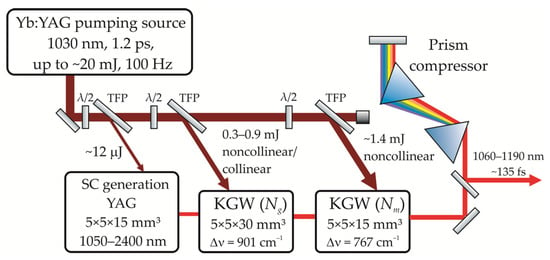
Figure 1.
Experimental setup for investigation of transient stimulated Raman chirped-pulse amplification (TSRCPA): λ/2—half-wave retardation plate; TFP—thin-film polarizers.
3. Results and Discussion
For a collinear configuration, efficient SC amplification in the first TSRCPA stage was observed already at a pump energy of 0.32 mJ, corresponding to a peak intensity of 12 GW/cm2 (Figure 2a). The mismatch between the pump electric field vector and the axis of the KGW crystal in a noncollinear configuration led to a ~25% increase in the pump energy to 0.4 mJ (15 GW/cm2) required for the same Stokes energy. When the SC seed was blocked, the SRS threshold was observed with a further increase in the pump energy by 53–58%, which corresponds to a peak intensity of 19 GW/cm2 for collinear configuration and of 23 GW/cm2 for noncollinear configuration. At even higher pump intensities, second-order Stokes and anti-Stokes radiation appears, which leads to saturation of the conversion efficiency and is accompanied by distortions of the amplified beam. Because of the better overlap of the pump and the seed beams in the collinear configuration, the second-order Stokes radiation appears at a much lower pump energy than in the noncollinear case. At an optimal pump pulse energy of 0.75 mJ (28 GW/cm2) and 1.2 mJ (45 GW/cm2), the maximum conversion efficiencies to the first Stokes of 5.8% and 6.4% were observed in the first TSRCPA stage for collinear and noncollinear configurations, respectively (Figure 2a).
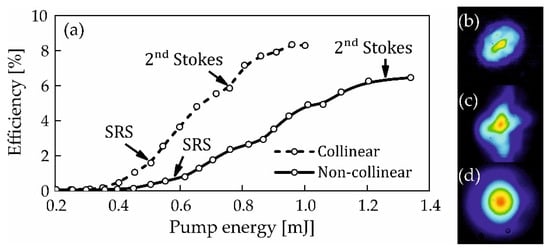
Figure 2.
(a) Conversion efficiency in the first TSRCPA stage versus the pump pulse energy for collinear (dashed) and noncollinear (solid) configurations. Amplified beam profiles for (b) a collinear case at a pump pulse energy of 0.9 mJ and (c) a noncollinear case before and (d) after spatial filtering at a pump pulse energy of 1.3 mJ.
Even below the second-order Stokes generation, the amplified beam was distorted in both cases (Figure 2b,c). In a collinear configuration, the amplified Stokes beam could not be spatially separated from the coincident SRS radiation with the same spectral components as the amplified signal. In this case, when we use transform-limited pump pulses, the generated parasitic SRS pulse has a frequency-independent spectral phase [4], in contrast to the linearly chirped amplified signal [13]. Thus, parasitic radiation not only distorts the amplified Stokes beam but can also hinder further pulse compression. Meanwhile, in the noncollinear case, the SRS and pump beams propagate along the same direction and are spatially separated from the amplified seed. Although the amplified Stokes beam consisted of a center and a peripheral area (Figure 2c) with conical anti-Stokes components [17] in accordance with the angle between the seed and pump, the iris aperture made it possible to separate the central Gaussian spot with a 30% signal pulse energy loss (Figure 2d). The spectra of amplified Stokes pulses after the first TSRCPA stage significantly broaden with increasing energy (Figure 3b,c) as well as the spectral bandwidth of the pump pulse (Figure 3a) due to SPM in both configurations. Under the same pumping conditions, the bandwidth of the amplified pulse in the collinear case is larger than in the noncollinear one. In particular, at a pump energy of 0.9 mJ, the bandwidth of the amplified pulse in the collinear configuration expands to 13 nm (FWHM), which is sufficient for a transform-limited pulse of 142 fs. Meanwhile, at the same pump pulse energy in the noncollinear case, the amplified pulse bandwidth was only 9.5 nm (FWHM), which corresponds to a transform-limited pulse of 194 fs. It should be noted that a further increase in the pump energy to an optimal value of 1.2 mJ provides a spectral bandwidth of up to 12 nm (FWHM).
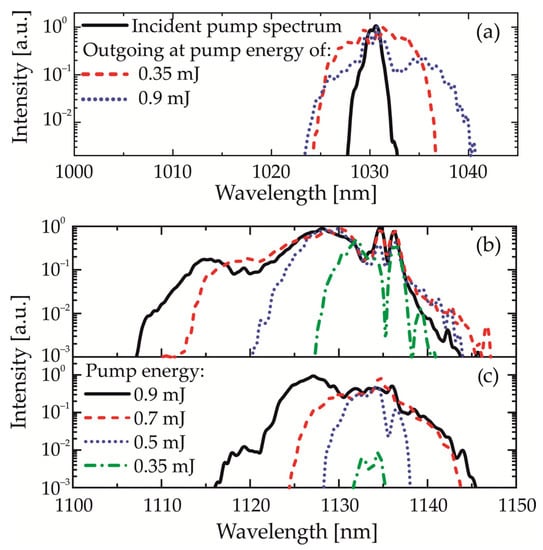
Figure 3.
Spectra (a) of the incident (solid) and outgoing pump pulse after a 30 mm KGW crystal at different energy levels (dashed and dotted). Spectra after the first TSRCPA stage in (b) collinear and (c) noncollinear configurations at different pump energy levels.
For both configurations, the greatest spectral broadening is achieved at the optimal delay between the seed and pump pulses, when the best gain is observed, and in both cases, with increasing pump energy, the amplified Stokes pulse predominantly broadens towards shorter wavelengths. This is explained by the fact that, in transient SRS, the Stokes pulse is formed at the trailing edge of the pump pulse [18]. During the SPM pump pulse, red- and blue-shifted frequency components appear at the leading and trailing edges, so the amplified Stokes pulse basically replicates the frequency and phase structure of the trailing edge of the pump pulse. Consequently, a more significant spectral broadening to the short-wavelength range is observed. Such asymmetric broadening is handy for further spectral synthesis at the second TSRCPA stage, in which the spectrum from the first stage should overlap with the adjacent Stokes component corresponding to 767 cm−1.
The study also revealed that the bandwidth and output energy of amplified pulses in a noncollinear configuration strongly depend on the location of the spatial overlap of the seed and pump pulses along the KGW crystal (Figure 4).
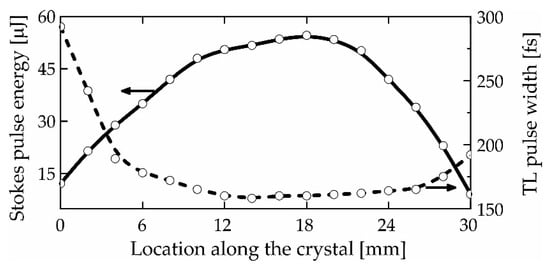
Figure 4.
Stokes pulse energy (solid) and transform-limited pulse width calculated from the measured output spectrum (dashed) versus the position of the spatial overlap of the pump and seed beams in the KGW crystal for a noncollinear configuration.
The widest spectrum was observed when the interacting pulses were overlapped in the middle of the 30 mm KGW crystal. In other cases, when the pump and seed pulses overlap in the input and output sections of the crystal, the bandwidth of the amplified pulses narrows to 9.5 and 11 nm (FWHM), respectively. This is explained by the fact that, when the pulses are overlapped in the input part of the KGW crystal, the effect of the SPM on the pump pulses is still insufficient to cause its significant spectral broadening. Therefore, in turn, the spectral bandwidth of the Stokes pulses is smaller. Meanwhile, as the pump pulse propagates along the crystal, the acquired SPM is large enough to affect the bandwidth of the Stokes pulse. When the pulses interact in the middle of the crystal, where the Stokes pulse reaches its maximum energy, the SPM of the amplified pulse imparts additional spectral broadening. With an increase in the length of the crystal passed by the pump pulse before overlapping with a seed from 20 to 30 mm, a sharp decrease in the energy of the amplified Stokes pulse is observed. This leads to a weakening of the SPM of the Stokes pulse with a decrease in its spectral bandwidth. Meanwhile, the noncollinearity angle did not significantly affect the gain bandwidth. The larger mismatch between the direction of the pump electric field vector and the axis of the KGW crystal led only to a slight decrease in the conversion efficiency when this angle increased. As a result, a minimum noncollinearity angle of ~2° was determined to be optimal. Thus, in terms of the set of experimentally confirmed advantages, namely, a higher second-order Stokes threshold, a higher optimal pump and amplified Stokes energy, a better beam quality after spatial cleaning, and simplicity in separating the accompanying SRS, a noncollinear configuration is proposed as the best method for maintaining a wide TSRCPA bandwidth.
The second TSRCPA stage was tuned to the adjacent vibrational mode of the KGW crystal at 767 cm−1, which made it possible to synthesize an extremely wide tailored spectral bandwidth of ~38 nm (Figure 5a) corresponding to the transform-limited pulse of 50 fs (Figure 6b—dotted line) at a central wavelength of 1120 nm. In this case, the short-wavelength and long-wavelength wings of the amplified Stokes spectrum are in the same polarization, in contrast to the simultaneous excitation of several vibrational modes in a single KGW crystal [13].
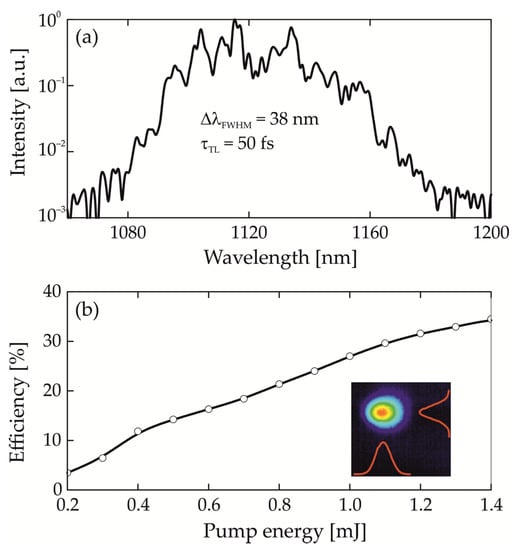
Figure 5.
(a) Synthesized spectra after two TSRCPA stages tuned to vibrational modes at 901 and 767 cm−1 of a KGW crystal. (b) Conversion efficiency in the second TSRCPA stage versus pump pulse energy and (inset) amplified beam profile at a pump energy of 1.4 mJ. τTL—transform limited pulse width.

Figure 6.
(a) Synthesized spectrum after two TSRCPA stages (solid black), FROG-retrieved spectral intensity profile (solid red), and its spectral phase (dashed) before compression. (b) Temporal profile (solid) of amplified pulse after compression retrieved from the SHG-FROG measurement, compared to transform-limited pulse calculated from the measured spectrum (dotted) and the retrieved temporal phase (dashed). τTL—transform limited pulse width.
A conversion efficiency 35% was achieved (Figure 5b) at a pump pulse energy of 1.4 mJ, corresponding to 30 GW/cm2. Obviously, due to the large mismatch between the center wavelengths, adjacent wings of the synthesized spectrum are amplified independently. As a result, the conversion efficiency was lower compared to the amplification of a single Stokes component in two successive TSRCPA stages [13]. Indeed, additional amplification stages or a multi-pass cell (MPC) can be used to further improve conversion efficiency [19].
The measured spectrum, the FROG-retrieved spectrum, and its phase for the amplified pulse after spectral synthesis in a two-stage amplifier are shown in Figure 6a. It can be seen that the synthesized pulse has a positive chirp imprinted from supercontinuum pulses, which is accompanied by significant spectral phase modulations (Figure 6a—dashed line). Unfortunately, we cannot pinpoint exactly what caused the phase modulations. We assume that the phase distortions of the pump pulse caused by the SPM are transmitted to the Stokes pulses during amplification. The B-integral of the pump radiation accumulated in the first TSRCPA stage exceeded 9, which certainly affects the amplified Stokes phase structure. Meanwhile, in the second stage, the B-integral did not exceed 3; therefore, the spectral phase structures of adjacent Stokes modes induced by the SPM were different. In addition, Stokes SPM during amplification can also have some effect on the spectral phase distortions of the amplified signal. After two TSRCPA stages, a synthesized pulse width of ~1 ps was observed. Despite the fact that the synthesized pulse has an inhomogeneous spectral phase, it is of interest to be able to compress it to at least ~100 fs. The delay in the second stage was optimized to compress the pulse with the best contrast. Otherwise, two zones can be observed in the temporal profile of the compressed Stokes pulse.
To achieve the shortest pulse width, the distance between the two prisms was varied experimentally. The resulting temporal quality is mediocre, with large pedestals and side pulses. Nevertheless, the shortest pulse width of 135 fs (FWHM) was achieved (Figure 6b—solid line), which is ~9 times shorter than the pump. Indeed, with passive compression, phase modulation is still clearly visible (Figure 6b—dashed line). Therefore, to approach the sub-100 fs pulse width, it is necessary to use active phase control, i.e., an acousto-optic programmable dispersive filter (AOPDF).
4. Conclusions
TSRCPA demonstrates the efficient amplification of ultrashort laser pulses with an extremely wide spectral bandwidth. For the selected single vibrational mode at 901 cm−1 in a KGW crystal, the TSRCPA was investigated in different amplifier configurations under transient excitation by transform-limited 1.2 ps pump pulses. The noncollinear configuration made it possible to increase the second-order Stokes threshold and ensure a higher optimal pump and amplified Stokes pulse energy, as well as a better quality of the amplified Stokes beam. In this case, the amplification of two adjacent vibrational Stokes components at successive TSRCPA stages provides a 23-fold increase in the composite bandwidth of amplified Stokes pulses compared to pump pulses with a maximum conversion efficiency of 35%. As a result, a spectral bandwidth of 38 nm was achieved at a central wavelength of 1120 nm. Despite the modulated spectral phase of the synthesized pulse, the compression of the amplified Stokes pulses to 135 fs was obtained experimentally. In addition, a possible extension of the concept under study can be a combination of various SRS-active materials with complementary Stokes shifts in successive TSRCPA stages in order to achieve an even wider spectral bandwidth. Alternatively, near-single cycle pulses can also be synthesized by combining spatially separated multiple-order SRS sidebands generated in a single crystal [20].
Author Contributions
Conceptualization A.P., A.M.R. and P.M.; methodology, A.P. and P.M.; validation, A.M.R.; formal analysis, A.P., A.M.R. and P.M; investigation, A.P. and P.M.; resources, A.P., P.M. and A.M.R.; data curation, A.P. and P.M.; writing—original draft preparation, A.P., P.M. and A.M.R.; writing—review and editing, A.P. and A.M.R.; visualization, P.M.; supervision, A.M.R.; project administration, A.M.R. All authors have read and agreed to the published version of the manuscript.
Funding
This research was funded by Research Council of Lithuania, grant number S-MIP-21-30.
Institutional Review Board Statement
Not applicable.
Informed Consent Statement
Not applicable.
Data Availability Statement
Not applicable.
Acknowledgments
We are grateful to Vytenis Girdauskas for his contribution to the experiment. Two authors are grateful for NATO SPS G5734 fellowships.
Conflicts of Interest
The authors declare that there is no conflict of interest.
References
- Hilfer, G.; Menyuk, C.R. Stimulated Raman scattering in the transient limit. J. Opt. Soc. B 1990, 7, 739–749. [Google Scholar] [CrossRef]
- Krylov, V.; Ollikainen, O.; Wild, U.P.; Rebane, A.; Bespalov, V.G.; Staselko, D.I. Femtosecond stimulated Raman scattering in pressurized gases in the ultraviolet and visible spectral ranges. J. Opt. Soc. Am. B 1998, 15, 2910–2916. [Google Scholar] [CrossRef]
- Krylov, V.; Rebane, A.; Ollikainen, O.; Erni, D.; Wild, U.P.; Bespalov, V.; Staselko, D. Stimulated Raman scattering in hydrogen by frequency-doubled amplified femtosecond Ti:sapphire laser pulses. Opt. Lett. 1996, 21, 381–383. [Google Scholar] [CrossRef]
- Jordan, C.; Stankov, K.A.; Marowsky, G.; Canto-Said, E.J. Efficient compression of femtosecond pulses by stimulated Raman scattering. Appl. Phys. B. 1994, 59, 471–473. [Google Scholar] [CrossRef]
- Zhavoronkov, N.; Noack, F.; Petrov, V.; Kalosha, V.P.; Herrmann, J. Chirped-pulse stimulated Raman scattering in barium nitrate with subsequent recompression. Opt. Lett. 2001, 26, 47–49. [Google Scholar] [CrossRef] [PubMed]
- Konyashchenko, A.V.; Losev, L.L.; Tenyakov, S.Y. Raman frequency shifter for laser pulses shorter than 100 fs. Opt. Express 2007, 15, 11855–11859. [Google Scholar] [CrossRef] [PubMed]
- Konyashchenko, A.V.; Losev, L.L.; Pazyuk, V.S.; Tenyakov, S.Y. Frequency shifting of sub-100 fs laser pulses by stimulated Raman scattering in a capillary filled with pressurized gas. Appl. Phys. B 2008, 93, 455–461. [Google Scholar] [CrossRef]
- Didenko, N.V.; Konyashchenko, A.V.; Kostryukov, P.V.; Losev, L.L.; Pazyuk, V.S.; Tenyakov, S.Y.; Molchanov, V.Y.; Chizhikov, S.I.; Yushkov, K.B. 40-fs hydrogen Raman laser. Quantum. Electron. 2015, 45, 1101–1104. [Google Scholar] [CrossRef]
- Krylov, V.; Rebane, A.; Erni, D.; Ollikainenm, O.; Wild, U.P.; Bespalov, V.; Staselko, D. Stimulated Raman amplification of femtosecond pulses in hydrogen gas. Opt. Lett. 1996, 21, 2005–2007. [Google Scholar] [CrossRef] [PubMed]
- Orlovich, V.A.; Malakhov, Y.I.; Popov, Y.M.; Busko, D.N.; Danailov, M.B.; Demidovich, A.A.; Apanasevich, P.A.; Chulkov, R.V. Raman conversion of femtosecond laser pulses in crystals. Laser Phys. Lett. 2012, 9, 770–774. [Google Scholar] [CrossRef][Green Version]
- Buganov, O.V.; Grabtchikov, A.S.; Malakhov, Y.I.; Popov, Y.M.; Orlovich, V.A.; Tikhomirov, S.A. Features of Raman amplification in KGW and barium nitrate crystals at excitation by femtosecond pulses. Laser Phys. Lett. 2012, 9, 786–789. [Google Scholar] [CrossRef]
- Mochalov, I.V. Laser and nonlinear properties of the potassium gadolinium tungstate laser crystal KGd(WO4)2:Nd3+- (KGW:Nd). Opt. Eng. 1997, 36, 1660–1669. [Google Scholar] [CrossRef]
- Mackonis, P.; Petrulenas, A.; Rodin, A.M.; Girdauskas, V.; Michailovas, A. Two-stage transient stimulated Raman chirped-pulse amplification in KGd(WO4)2 with compression to 145 fs. Opt. Lett. 2020, 45, 6627–6630. [Google Scholar] [CrossRef] [PubMed]
- Jakutis-Neto, J.; Lin, J.; Wetter, N.U.; Pask, H. Continuous-wave Watt-level Nd:YLF/KGW Raman laser operating at near-IR, yellow and lime-green wavelengths. Opt. Express 2012, 20, 9841–9850. [Google Scholar] [CrossRef] [PubMed]
- Mackonis, P.; Rodin, A.M. Laser with 1.2 ps, 20 mJ pulses at 100 Hz based on CPA with a low doping level Yb:YAG rods for seeding and pumping of OPCPA. Opt. Express 2020, 28, 1261–1268. [Google Scholar] [CrossRef] [PubMed]
- Mackonis, P.; Petrulenas, A.; Girdauskas, V.; Rodin, A. Stable 1100–2400 nm supercontinuum in YAG with picosecond pumping for simplified OPCPA. In Proceedings of the 2019 Conference on Lasers and Electro-Optics Europe and European Quantum Electronics Conference, Munich, Germany, 23–27 June 2019. [Google Scholar] [CrossRef]
- Grabtchikov, A.S.; Chulkov, R.V.; Orlovich, V.A.; Schmitt, M.; Maksimenko, R.; Kiefer, W. Observation of Raman conversion for 70-fs pulses in KGd(WO4)2 crystal in the regime of impulsive stimulated Raman scattering. Opt. Lett. 2003, 28, 926–928. [Google Scholar] [CrossRef]
- Lowdermilk, W.H.; Kachen, G.I. Coherent transient pulse propagation. Opt. Comm. 1976, 18, 68–69. [Google Scholar] [CrossRef]
- Daher, N.; Délen, X.; Guichard, F.; Hanna, M.; Georges, P. Raman wavelength conversion in a multipass cell. Opt. Lett. 2021, 46, 3380–3383. [Google Scholar] [CrossRef] [PubMed]
- Bahari, A.; Zhdanova, A.A.; Shutova, M.; Sokolov, A.V. Synthesis of ultrafast waveforms using coherent Raman sidebands. Phys. Rev. A 2020, 102, 013520. [Google Scholar] [CrossRef]
Publisher’s Note: MDPI stays neutral with regard to jurisdictional claims in published maps and institutional affiliations. |
© 2022 by the authors. Licensee MDPI, Basel, Switzerland. This article is an open access article distributed under the terms and conditions of the Creative Commons Attribution (CC BY) license (https://creativecommons.org/licenses/by/4.0/).